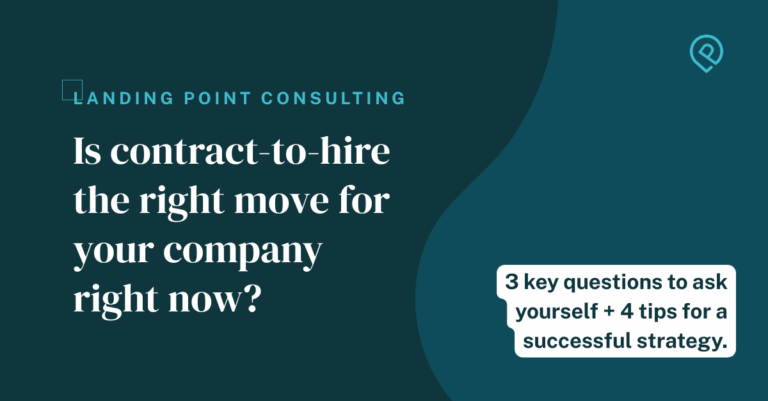When economic + regulatory changes = uncertainty across the board, one particular area that companies start to reevaluate is their hiring strategies. That’s where contract-to-hire solutions come in—a flexible approach that allows companies to bring in top consulting talent without making an immediate full-time commitment.
At Landing Point, we’re seeing a lot of companies lean into a contract-to-hire strategy right now, primarily to:
- Bridge hiring freezes while maintaining business continuity
- Speed up decision-making when HR processes slow hiring down
- Test out new skill sets beyond traditional candidate profiles
This approach gives companies the agility to assess talent in real-time, ensuring they find the right long-term fit.
When Contract-to-Hire Makes the Most Sense
- When market conditions are uncertain. Economic slowdowns, industry shifts, or political changes can create hesitation around full-time hiring. Contract-to-hire allows companies to move forward with critical hires while keeping options open.
- When HR bottlenecks slow hiring. Internal hiring processes can be slow, but business needs don’t wait. A contract-to-hire model ensures teams get the support they need while HR teams finalize approvals.
- When you’re expanding talent criteria. Sometimes, the best candidates don’t fit the traditional mold. Contract-to-hire allows companies to take calculated risks, bringing in talent with diverse skill sets to test alignment before committing.
How to Make Contract-to-Hire Work for You
- Work with a recruiter who understands your culture. A contract-to-hire strategy is only effective if the candidates align with your team’s working style, values, and long-term needs. A recruiter who deeply understands your company can help ensure a smoother transition.
- Set clear expectations upfront. Define success criteria for the contract period. What skills, culture fit, and performance metrics will determine if the hire transitions to full-time?
- Create a smooth onboarding experience. Treat contract-to-hire employees like full-time team members. Give them the same access to information, tools, and training to help them integrate quickly and contribute effectively.
- Move quickly on top talent. The best contract-to-hire candidates are in demand. If someone is proving their value, don’t wait until the contract is over—extend a full-time offer as soon as they demonstrate the right fit.
The Bottom Line
In uncertain times, companies that stay agile gain a competitive edge. Contract-to-hire is a powerful tool for businesses that need top talent but aren’t ready to commit to full-time hires. Whether you’re navigating economic shifts, HR slowdowns, or evolving job requirements, this strategy ensures you don’t put hiring on pause.
Need guidance on implementing a contract-to-hire strategy? Landing Point specializes in identifying consulting talent that seamlessly integrates into your team. Let’s discuss how we can help you build a flexible workforce for 2025 and beyond.

